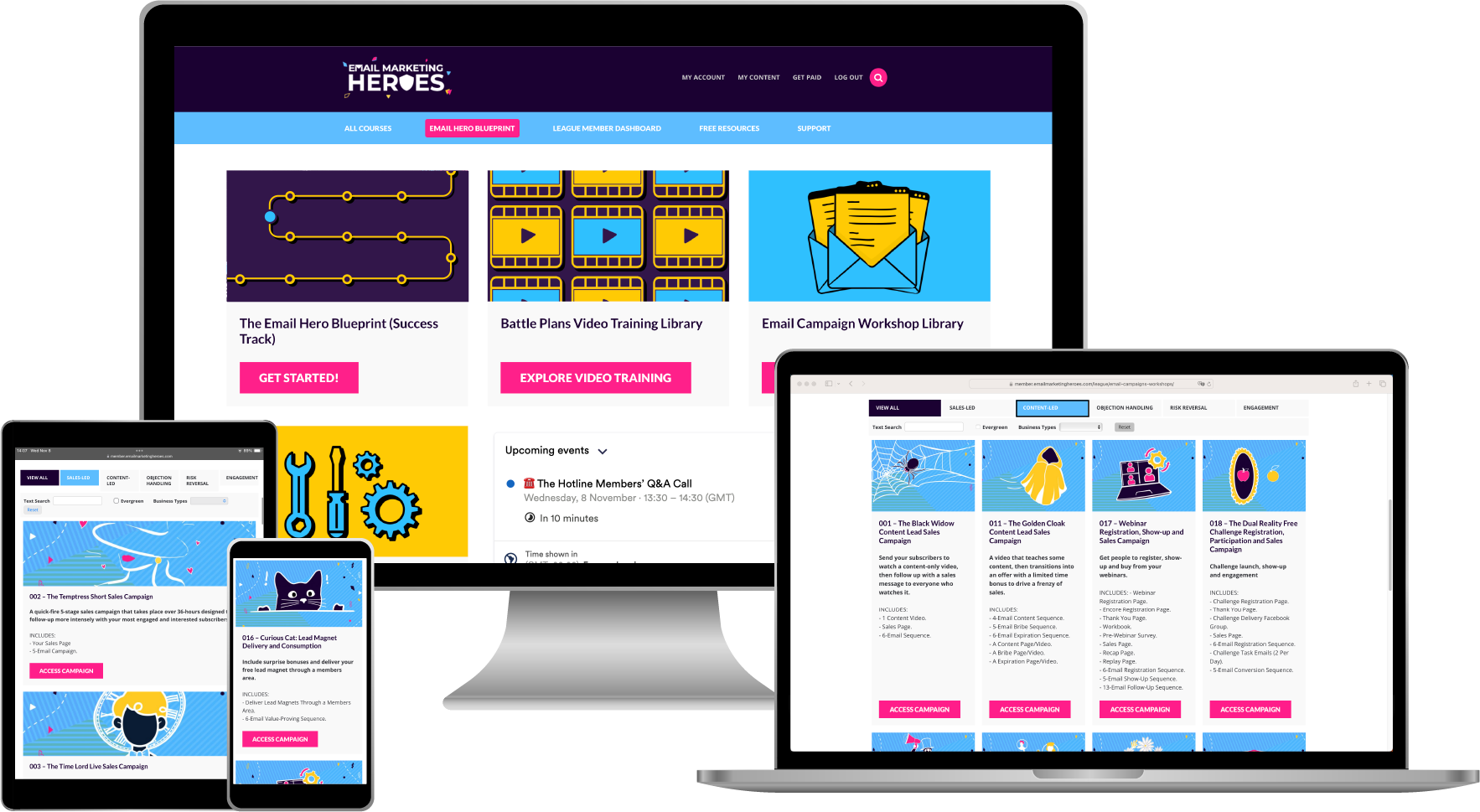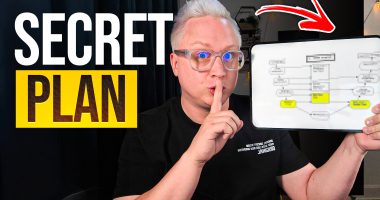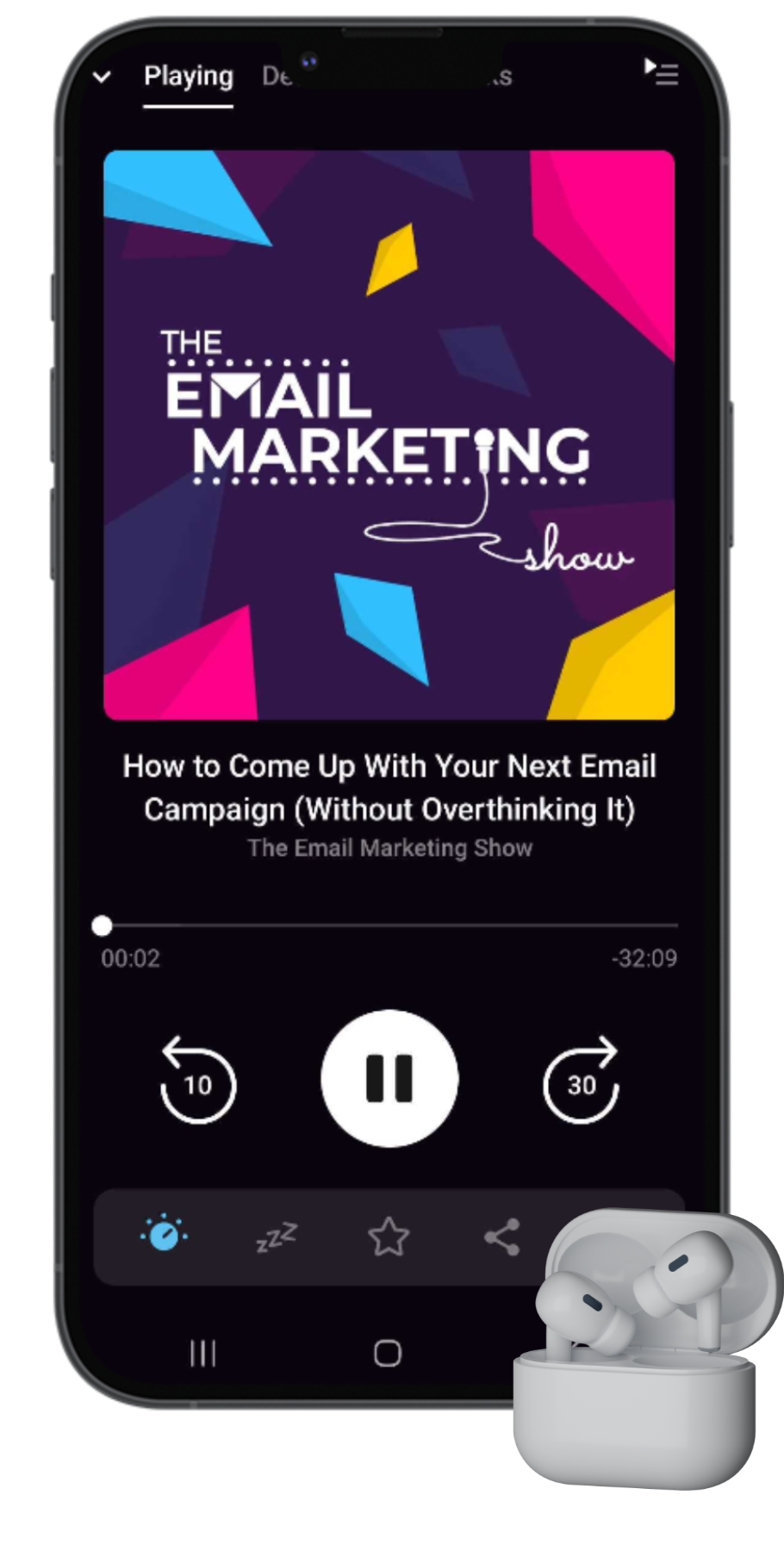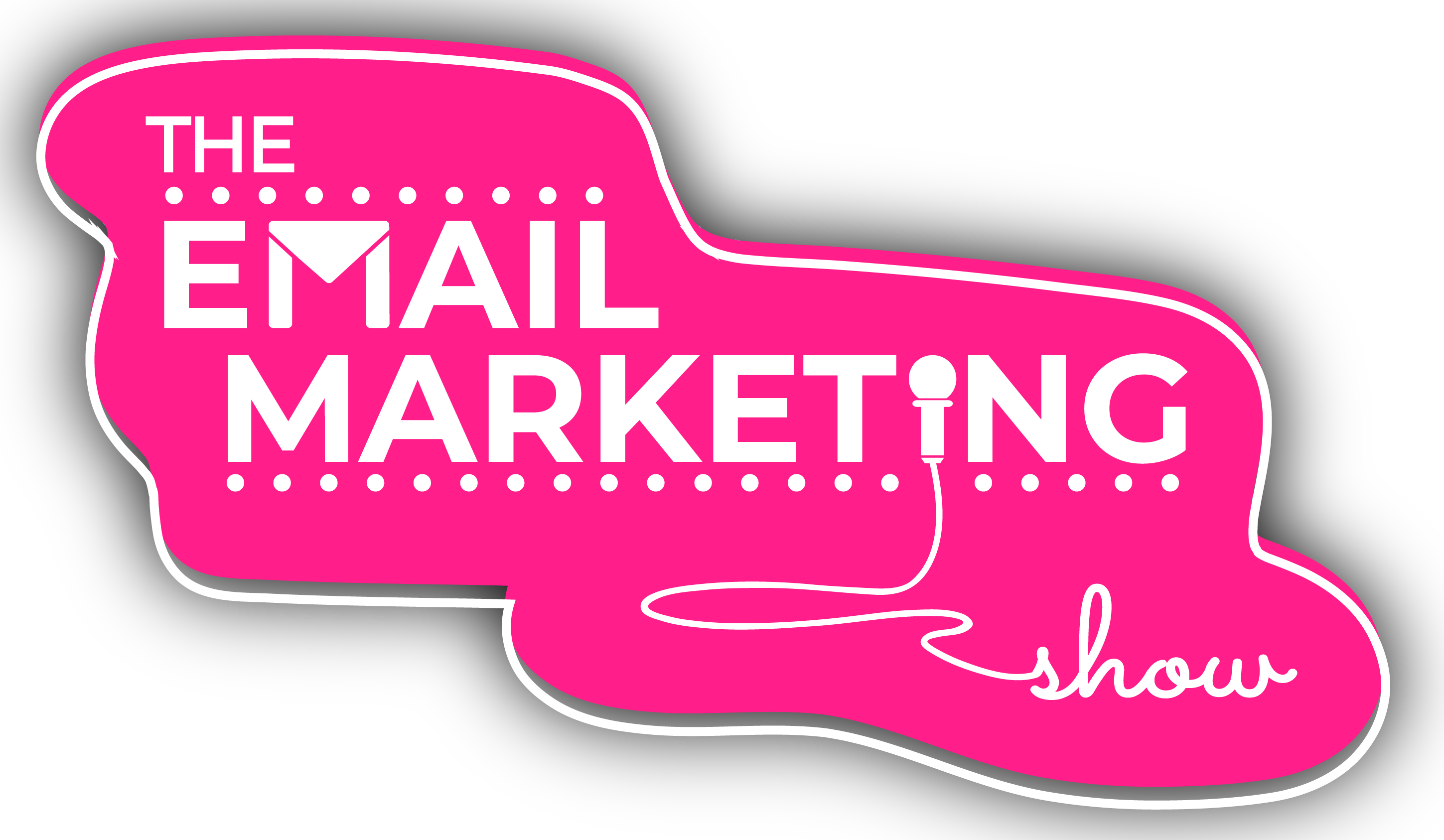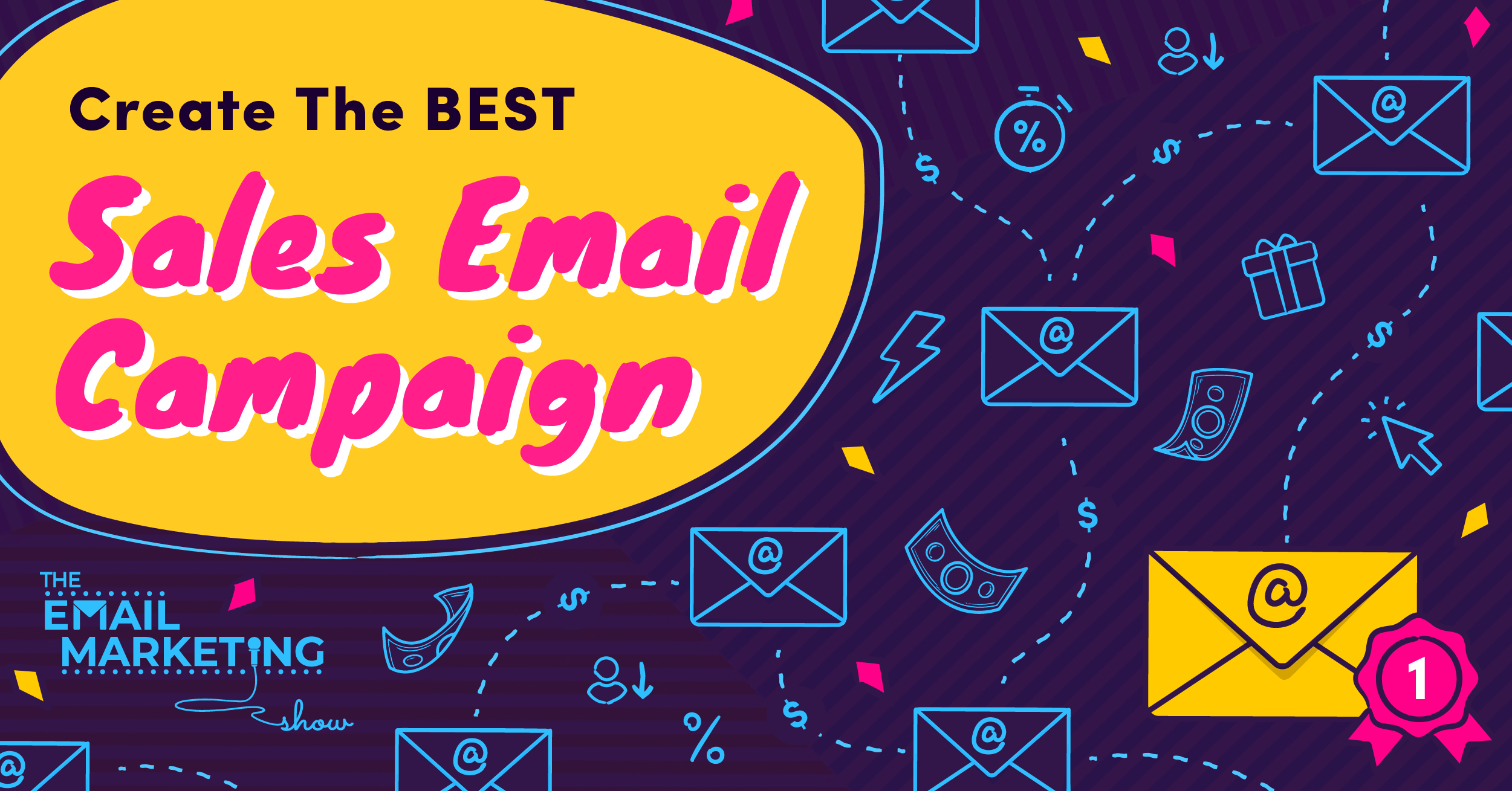
Everything You Need To Know About Running Your Most Successful Sales Email Campaign To Date (And Improve Your Email Marketing)
How do you run the perfect sales email campaign? Should you try and sell in every email you send? When do you send live, broadcast emails and when do you create automated campaigns?
These are only some of the questions we answer for you today.
And we're willing to bet you can't wait to get all the awesome sauce on this.
So let's just get into this, shall we? Let's go!
SOME EPISODE HIGHLIGHTS: (0:09) Join our FREE Facebook group. (3:59) How often should you sell in your emails? (7:40) When should you send out an email sales campaign? (12:54) What kind of emails should you include in your sales campaign? (16:50) What should you talk about in the emails inside your campaigns? (20:51) What if people unsubscribe from your sales emails? (23:31) What results should you expect from your sales emails? (24:33) How to create an 'email engine' of sales campaigns. (28:59) Join us for a FREE web class! (29:41) Subject line of the week.
How often should you sell in your emails?
We have a controversial answer to this question. Because email marketing has a cost – every time you send an email, some people will unsubscribe. You may not be selling directly in an email, but you always have to direct people to something they can buy. Because if you're not doing that, you might be losing people through unsubscribes and not making sales!
But also, if you’re not selling or directing people towards your product, you’re adding more overwhelm and distraction to that person’s world. And no one needs more of that!
What you want to do is to stay in your lane. You have a specialism, so take everybody on your list and on your social media through the beliefs and understandings they need to buy from you. Anything you do and say outside of selling is just more shiny object syndrome. The person is going to get distracted from what you’re talking about, which doesn’t serve you or them.
Remember that the people on your list have made the decision to share their email addresses based on something they saw from you. They know you have a solution, and they're interested. So make sure that in all your emails, you send them information that moves them towards buying.
Email isn't the same as social media!
The big misunderstanding is that every time you send an email you’re bothering someone – they're going to get annoyed. But even if you're selling to people (or moving people towards buying) in every single email you send, you have to remember email isn’t the same as social media. Social media platforms are a great place to teach people, and not traditionally a place where you sell.
Email is different. It's designed for short, useful communication that nudges people in the right direction. It's not the place to be putting long articles or to be referring people to free content all the time. Because people are on your list to solve a problem. And the faster you can help them to get to a solution to that problem, the better.
When should you send out an email sales campaign?
Our daily emails
Let’s talk about the differences between day-to-day email marketing and sales campaigns. Fundamentally, our business is based on the idea that we email our subscribers every day of the year. We send a short email every day with a few hundred words in it. And it’s usually (although not always) some sort of story from day-to-day life with some kind of lesson (like a teaching moment or some inspiration) that segues into an offer. Sometimes we might ask people to go and listen to a podcast episode, for example. But generally speaking, we sell every day.
And even when we don't sell, all of our emails have our Super Signature at the bottom, which has a menu of things that you might be interested in. If, on that day and at that exact moment, you’re looking to take the next steps, you have all the links to go and do that. In fact, our Super Signature makes sales every single week for us.
Automated sales campaigns
But we also have sales campaigns. These are full sequences of emails where all the emails work together – they’re not standalone bite-sized pieces. If you send an email today, one tomorrow, and one the day after, it’s like throwing snowballs at someone. It’s a bit like going to watch the sequel to a movie where it doesn’t really matter if you’ve seen the first movie or not because the second movie will still make sense on its own. Daily emails work like that. Because they don’t act together.
But with a sales campaign (while each email still needs to make sense on its own) they’re all part of a bigger picture. They’re not standalone. There’s an endpoint because the offer you talk about in the campaign is going to end. So all emails in that campaign lead to a specific destination. That means you have to communicate everything about this offer between the start and end date of the campaign. All the emails you send need to help you build the case, the beliefs, the excitement, the desire, and the proof for someone to go and buy from you.
Plus, there needs to be a consequence at the end of this campaign. For example, the bonus ends, and the offer is gone. Or you're going to stop talking about this for a while. Let’s say you were selling an affiliate offer – that product might still be available via someone else, but you’re no longer offering it. You created a sales event out of it, and now the offer is over. Just remember that every email in your campaign needs to build up to an endpoint.
A sales campaign has a specific structure – we use the acronym SVVC (which stands for Seed, Validate, Verify, and Close) to teach the various jobs that the emails in a sequence have to do.
What kinds of emails should you include in your sales campaign?
Send emails to sell!
Why do you want to follow a specific structure? Because you don't want to show up in someone’s inbox pretending you’re a friend and then suddenly try to sell them something – that’s aggressive. It’s a surprising flip, and people won’t like that. What you want to do from the beginning of your relationship with each subscriber, is to train them to buy. Show them that you're selling to them regularly. Because you can't start doing it all of a sudden.
In fact, one of the things we see over and over is email marketers nurturing their subscribers to death and to the point where people no longer read their emails. They get to a point when they’re not even considering buying from you anymore – you’re just a friend who shows up!
We don’t believe in the method of giving loads and loads, hoping that people will eventually buy. Most of us don’t have the luxury of financial backing or playing the long game – we don’t have deep enough pockets! What our types of businesses need instead is an ROI – a return on investments. And a quick one at that! Because if we’ve invested money (on ads, for example) to get people on our email list, we need to make that money back.
And the only way we can do that is by having sales campaigns early in our subscriber’s journey instead of nurturing people to death. We don’t want people to go and buy the solution from someone else because we haven’t offered them anything, do we? A major part of selling is amplifying and putting a focused spotlight on the pain, and that doesn’t work if we do it to death.
Have good reasons for sending emails!
You want every email you send to have its own specific reason. In a campaign, you have enough room to go into detail on one specific thing about you, your product, the audience, the beliefs, the social proof, etc.
In fact, one of the worst mistakes we see people make is to tell their audience everything they possibly want to say in one email. Doing that is a mistake! Because it means you have no more points to make in your other emails. Also, if you bury all your valuable points (such as overcoming objections or building beliefs) all in one email, people might miss it! You have to address these points in a way that’s noticeable.
What should you talk about in the emails inside your sales campaign?
Here are things that you can each put in individual emails. And please don't ask the question in the subject line and then answer it in the email. This is important because the underlying hook, strategy, or angle will ultimately make up at least 80% of the success of your email campaign, so you want to get this right.
Here are some ideas for topics (each one is one separate email):
- Explain who your product is for.
- Explain the specific problem and transformation people are going to get.
- Go through the success other people have experienced with this product. (You can share more than one case study in different emails).
- Talk about why your product or solution is unique or better than what people may have already tried.
- Send an email based on personal urgency – why should someone fix this problem now? Why is this problem personally urgent?
- Or, instead, give everyone a fixed reason why they need to buy now. For example, that could be because your offer is going away, and after that, the price will be going up.
- And on that last point, if you have actual urgency because the offer is closing, then send a few emails the day before and on the last day to remind people that they’re going to miss out if they don’t buy right now.
Why so many emails?
You’re effectively looking for reasons to send more emails. And if you put all the above information in just one email, then you literally have nothing more to say. We even send an email after the cart has closed to let people know that the offer is gone, and they’ve missed out. And we do that because it’s important to prove to people that when you say something, it really does happen. We call it the SIPI method – say it, prove it. You can even ask people to join a waiting list to be notified when that offer may become available again in the future.
So why so many emails? Because your sales campaigns help you create the right beliefs. It's not just about selling – it's also about showing people that when you say something, you deliver on that promise. And they’ll know for next time.
As long as you have a good reason for sending emails, there’s no such thing as sending too many emails. That only happens when you repeat yourself or send emails for no reason. If you see people unsubscribe because of that, that’s fair enough. But as long as you’re answering questions that people actually have, they’ll be invested. And that means you won’t lose as many subscribers.
What if people unsubscribe from your sales emails?
We treat unsubscribes differently depending on what people are unsubscribing from. If you're running a sales email campaign around your core offer (which we call your Rome because all roads lead to Rome), you want everyone to get that product. And if people unsubscribe at the back of the emails that talk about your core product, let them go. If they’re never going to be interested in buying your main product, you probably don’t want them on your list anyway.
However, if you’re sending a campaign about something that’s not your Rome offer, you can do something we call granular unsubscribe. For example, we run a campaign a few times a year that only goes out to people who bought from us in the past but aren’t our existing customers. It doesn’t go out to our main list – only to a specific segment. And that’s an invitation to join our Email Engine Accelerator, which isn't our main offer. It’s a phenomenal, limited, small-group programme with a strict ceiling on how many people can get in.
So we send out an email campaign to invite people to join this programme and include a manual link at the bottom so people can remove themselves from that segment if they're not interested in that product. We add a specific tag to those people in our system, but we don't remove them from our list entirely. That’s what we call granular unsubscribe, and it allows people to remove themselves from a particular segment that’s not related to our Rome offer.

The Top 10 Books To 'Power Up' Your Email Marketing
10 book recommendations that will improve all areas of your email marketing (including some underground treasures that we stumbled upon which have been game-changing for us).
What results should you expect from your sales emails?
When you send out sales email campaigns, you can expect two things – sales and unsubscribes. And of course, the sales will help counteract and balance your unsubscribes. This is the reason why you have to make offers in all your emails – because every time you send an email, some people are going to unsubscribe. And to counterbalance that, you need to get sales.
This isn’t a game of list building – it’s a game of customer acquisition! How many of the subscribers on your list can you turn into paying customers?
How to create an 'email engine' of sales campaigns
Let's do a quick overview of how our system works as a whole. First of all, people join our email list, opt in, and get our lead magnet. Then they go through what we call our email engine. That is a sequence of well-thought-through email campaigns.
We have:
- A sales campaign,
- A content-led sales campaign,
- An objection-handling sales campaign,
- And a risk-reversal sales campaign.
All our subscribers go through these campaigns after our welcome sequence (the Get To Know You sequence), which is engagement-driven. When people receive these campaigns, the emails look and feel like the daily emails we promised them when they first signed up. They roughly follow a daily cadence, even though sometimes they’re more frequent.
About 80% of the people who ever buy from us do so within 60 days of joining our list and while going through the automated campaigns of our email engine. After that, they start receiving our real, live, daily emails, which are being sent to everyone who’s already completed the engine. Those emails are designed to keep people warm, engaged, and clicking and replying to our emails.
Running additional sales campaigns
Every now and then, we run sporadic sales campaigns. These might be about the same things we offer in our daily emails, but also promote specific bonuses or discounts, for example. Inside our membership The League, we have campaigns specifically designed for this (with a strong risk-reversal element), such as our Bribe campaign or our Golden Cloak campaign.
Or, we might pick a big objection as to why people haven’t bought from us yet and run an objection-handling campaign instead. Other times, we might decide to run a campaign because we’ve launched a new product. Or we might offer an affiliate product so we can earn commissions on sales.
When those ad-hoc campaigns end, we go back to daily emails for as long as we want to or need to. Of course, for you, if you don’t send daily emails, these are the live, broadcast emails you send regularly to your list at whatever frequency you set.
And then finally, we have silent campaigns that are waiting in the wings to be deployed and specifically target people's levels of engagement. If we see people who are very engaged and looking at a specific product, we send them the Tell Me More campaign to try and sell this thing they’re interested in. On the flip side, if someone’s become super disengaged (i.e. they haven’t clicked on a link in 60 days), we put them through our LOL Revival campaign. We give them a chance to re-engage, and if they don’t, we remove them from our list.
Join us for a FREE web class!
If you want to understand how this all fits together, we have a brand new free web class where we’re going to show you exactly how we do it, and how it all works together. Simply head over to this link and access our FREE web class.
Subject line of the week
This week’s subject line is just the word “Timewaster.” This is great because, on the surface, this subject line may seem accusatory. You see it in your inbox, and you might think you’ve done something wrong, and you’re going to get in trouble. So you open the email to check, and you find out it’s really nothing, which is a lovely, relaxing feeling of relief. So check it out!
Useful Episode Resources
Related episodes
How To Run A Smashing Flash Sale With One of The Best Email Marketing Campaigns In The World.
Template For Email Marketing Campaigns.
How To Create THE Most Successful Re-Engagement Email Campaign (And Smash Your Sales Targets)
FREE list to improve your email marketing
If you want to write better emails, come up with better content, and move your readers to click and buy, here's how. We put together this list of our Top 10 most highly recommended books that will improve all areas of your email marketing (including some underground treasures that we happened upon, which have been game-changing for us). Grab your FREE list here.
Join our FREE Facebook group
If you want to chat about how you can maximise the value of your email list and make more money from every subscriber, we can help! We know your business is different, so come and hang out in our FREE Facebook group, the Email Marketing Show Community for Course Creators and Coaches. We share a lot of training and resources, and you can talk about what you're up to.
Try ResponseSuite for $1
This week's episode is sponsored by ResponseSuite.com, the survey quiz and application form tool that we created specifically for small businesses like you to integrate with your marketing systems to segment your subscribers and make more sales. Try it out for 14 days for just $1.
Join The League Membership
Not sick of us yet? Every day we hang out in our amazing community of Email Marketing Heroes. We share all of our training and campaigns and a whole bunch of other stuff. If you're looking to learn how to use psychology-driven marketing to level up your email campaigns, come and check out The League Membership. It's the number one place to hang out and grow your email marketing. Best news yet? You can apply everything we talk about in this show.
Subscribe and review The Email Marketing Show podcast
Thanks so much for tuning into the podcast! If you enjoyed this episode (all about how to create and run the most successful sales email campaign ever) and love the show, we'd really appreciate you subscribing and leaving us a review of the show on your favourite podcast player.
Not only does it let us know you're out there listening, but your feedback helps us to keep creating the most useful episodes so more awesome people like you can discover the podcast.
And please do tell us! If you don't spend time on email marketing, what do you really fill your working days with? We'd love to know!

